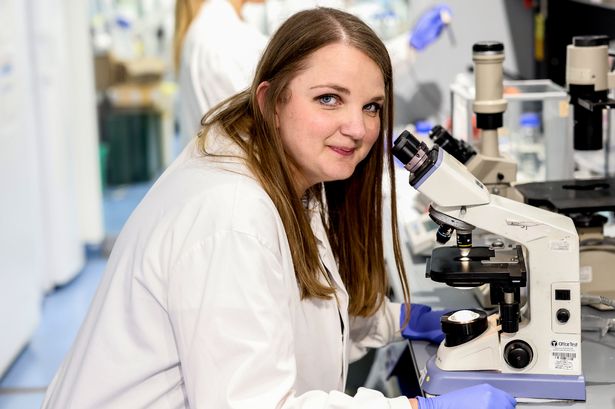Science
Scientists Create Miniature Brains to Combat Alzheimer’s Disease

Scientists at the Blizard Institute, Queen Mary University of London, are making significant strides in Alzheimer’s research by growing miniature brains to better understand the disease that affects nearly one million people in the UK alone. Funded by the Alzheimer’s Society, this innovative research aims to track the changes in the brain that lead to memory loss and personality changes, with hopes of finding effective treatments within our lifetime.
Alzheimer’s disease, the leading cause of dementia, is often misunderstood as a normal part of aging. Dr. Cara Croft, a neuroscientist involved in this groundbreaking study, emphasizes that it is not an inevitable consequence of growing older. Her commitment to dementia research stems from a desire to provide hope to millions facing uncertain futures due to this condition.
Dr. Croft reflects on her career path, stating, “At one point I was thinking of becoming a clinical doctor, but I didn’t want to say to patients, ‘sorry, you’ve got a disease that causes dementia but there’s not really anything we can do for you.’” By pursuing scientific research, she believes they can make a real impact in the field.
The research team, consisting of PhD students Miranda Colman, Daniel Birtles, and Gabriela Da Cruz Meda, along with research technicians Abhiram Chakka and Mia Bovis, has been awarded five years of funding to explore ten drugs that may lead to a cure for dementia. Their work involves creating brain slice cultures from human skin cells, which they then monitor for the behavior of a protein called tau.
Dr. Croft explains the significance of tau, saying, “When tau becomes sticky, that’s when we know there’s a problem inside the brain.” Tau helps maintain the structural integrity of nerve cells, and its accumulation is linked to the symptoms of Alzheimer’s. The researchers are uncovering how tau’s stickiness correlates with neuron death, which ultimately leads to memory loss and cognitive decline.
Recent findings from Dr. Croft’s research challenge previous assumptions about tau’s role. “The classical thinking on tau was that it would clog up and then the brain cell would die,” she notes. “But what we showed is there’s some kind of ‘housekeeping’ going on in the cell.” This discovery opens new avenues for understanding how tau recycling can be improved, potentially leading to therapeutic interventions.
The lab environment is dynamic, with technicians like Abhiram Chakka working to create a nutrient-rich solution that mimics cerebrospinal fluid, essential for nurturing the brain slice cultures. “This is the food for the brain slice cultures, containing all the essential nutrients required for the growing and sustenance of the tissue,” he explains.
After approximately 100 days of development, the researchers utilize genetic editing techniques to induce tau aggregation within the cultures. By flooding the brain slices with a colored dye, they can visualize and monitor the cells involved in the recycling process aimed at clearing the sticky tau.
PhD student Daniel Birtles expresses the excitement of being part of this pioneering work, stating, “There’s something about looking at results that no-one has ever seen before. It feels like a privilege that is not afforded to everyone.” He acknowledges the importance of connecting their scientific efforts with the real-world impact on patients, reinforcing their motivation.
Similarly, Miranda Colman shares her personal connection to dementia, noting that many people experience its effects through family and friends. “The statistics can’t begin to capture the impact that dementia and Alzheimer’s has on our society,” she remarks. This emotional drive fuels the team’s commitment to their research, especially during challenging moments in the lab.
Dr. Croft maintains an optimistic outlook on the future of Alzheimer’s research. “I wouldn’t be researching Alzheimer’s if I didn’t believe we can find treatments to slow, cure or prevent this disease in our lifetimes,” she asserts. The ongoing studies could lead to clinical trials aimed at boosting tau recycling with safe medications.
The work being done at the Blizard Institute represents a small but critical part of the broader effort to combat Alzheimer’s disease. As the team continues to push the boundaries of scientific understanding, their dedication offers hope for future breakthroughs that could improve the lives of millions affected by this debilitating condition.
For further information or to support Alzheimer’s research, visit www.alzheimers.org.uk.
-

 Health3 months ago
Health3 months agoNeurologist Warns Excessive Use of Supplements Can Harm Brain
-

 Health3 months ago
Health3 months agoFiona Phillips’ Husband Shares Heartfelt Update on Her Alzheimer’s Journey
-

 Science1 month ago
Science1 month agoBrian Cox Addresses Claims of Alien Probe in 3I/ATLAS Discovery
-

 Science1 month ago
Science1 month agoNASA Investigates Unusual Comet 3I/ATLAS; New Findings Emerge
-

 Science4 weeks ago
Science4 weeks agoScientists Examine 3I/ATLAS: Alien Artifact or Cosmic Oddity?
-

 Science4 weeks ago
Science4 weeks agoNASA Investigates Speedy Object 3I/ATLAS, Sparking Speculation
-

 Entertainment4 months ago
Entertainment4 months agoKerry Katona Discusses Future Baby Plans and Brian McFadden’s Wedding
-

 Entertainment4 months ago
Entertainment4 months agoEmmerdale Faces Tension as Dylan and April’s Lives Hang in the Balance
-

 World3 months ago
World3 months agoCole Palmer’s Cryptic Message to Kobbie Mainoo Following Loan Talks
-

 Science4 weeks ago
Science4 weeks agoNASA Scientists Explore Origins of 3I/ATLAS, a Fast-Moving Visitor
-

 Entertainment4 months ago
Entertainment4 months agoLove Island Star Toni Laite’s Mother Expresses Disappointment Over Coupling Decision
-

 Entertainment3 months ago
Entertainment3 months agoMajor Cast Changes at Coronation Street: Exits and Returns in 2025









